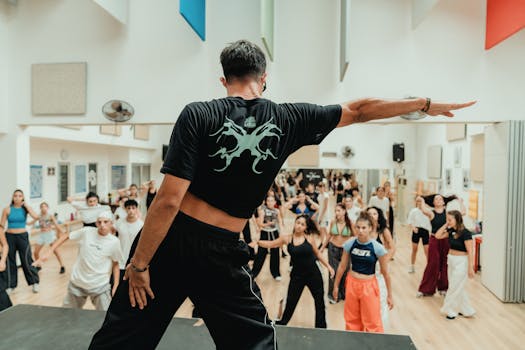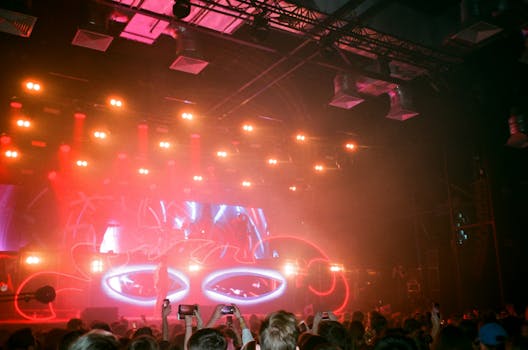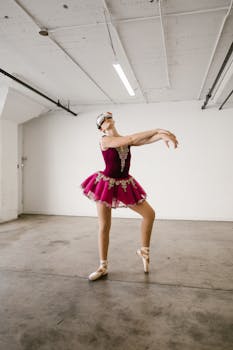Anúncios
Creating dance experiences can be a transformative journey for both participants and instructors. Whether you’re organizing a community event or a personal workshop, the magic of dance brings people together in unique and enriching ways.
From the energetic rhythms of hip-hop to the graceful movements of ballet, dance can be a form of expression and a powerful tool for connection. This article will guide you through the steps needed to develop unforgettable dance experiences for all skill levels.
With careful planning and an understanding of your audience, you can craft an engaging dance experience that celebrates diversity, creativity, and joy. Let’s dive into the essential elements that will help you create these memorable moments.
Understanding Your Audience
Before creating any dance experience, it’s crucial to understand your audience. Their interests, skill levels, and cultural backgrounds will shape your event’s direction.
Gathering demographic information can aid in tailoring your approach. Consider factors such as age, previous dance experience, and individual preferences to ensure your experience resonates.
Anúncios
Engaging with your target audience through surveys or informal conversations gives insights into what they seek from a dance experience. Their input fosters inclusivity and collaboration in the planning process.
Moreover, defining your audience will also help you choose appropriate music styles, choreography, and even thematic elements that will enhance the overall experience.
Ultimately, understanding your audience nurtures a sense of belonging, making participants feel valued and invested in the dance experience you create.
Anúncios
Setting Clear Objectives
Once you understand your audience, it’s time to set clear objectives for your dance experience. Consider what you hope participants will gain from attending your event.
Your goals could include promoting physical fitness, enhancing creativity, building community, or celebrating cultural heritage through dance. Clearly defined objectives guide your planning efforts.
By establishing these goals, you can measure the success of your event later. Ask yourself: “What do I want people to feel or learn?” This reflective process is vital.
Furthermore, keep your objectives in mind when crafting the structure of the dance experience. Every component should align with your overarching goals for maximum impact.
In conclusion, clear objectives will keep your event focused and purposeful, ensuring a rewarding experience for all involved.
Choosing the Right Venue
The venue you select plays a pivotal role in the overall success of your dance experience. It should be accessible, accommodating, and conducive to movement.
Consider the size of your audience to determine whether a large auditorium or an intimate studio best fits your needs. Space should allow for comfortable movement and interaction.
Additionally, think about the atmosphere you wish to create. Venues can be decorated or organized to reflect the theme of your event, adding to the experience.
Accessibility is also key; ensure that your chosen venue can accommodate individuals with disabilities. This attention to detail makes everyone feel welcomed and valued.
A well-chosen venue not only enhances the dance experience but also contributes to the participants’ comfort and willingness to engage fully.
Selecting Dance Styles and Themes
Selecting appropriate dance styles and themes is essential in crafting memorable dance experiences. Diverse genres can cater to various skill levels and preferences.
Consider incorporating styles like salsa, ballroom, or contemporary, depending on your audience’s interests. Mixing genres can keep things fresh and exciting!
Themes can be inspired by cultural movements, popular music, or even seasonal events. A cohesive theme can enhance the overall mood and purpose of your event.
Make your selections based on your audience’s feedback and the objectives set earlier. This will tie all elements together in a meaningful way.
Ultimately, the right combination of dance styles and themes provides a rich tapestry for participants to explore, enjoy, and engage with.
Creating an Engaging Environment
An engaging environment is foundational for a successful dance experience. Elements such as décor, lighting, and sound can significantly influence the atmosphere.
Consider soft lighting for a calming effect or vibrant colors for high energy. These choices help set the mood and empower attendees to immerse themselves.
Incorporate elements like visuals or props that enrich the experience and invite creativity. They can stimulate interest and encourage participants to express themselves freely.
Additionally, establishing a welcoming space can foster social connections among participants. Encourage mingling through ice-breaker activities to create a sense of community.
With a well-thought-out environment, you can enhance the emotional and physical experience of dance, ensuring that participants feel inspired to learn and connect.
Incorporating Instructional Elements
Instructors are key to any dance experience; their teaching style can greatly influence participants’ enjoyment and learning. Selecting knowledgeable and supportive instructors is vital.
Consider the format of instruction; you might choose workshops, demonstrations, or interactive classes. Each format can serve different objectives and audience preferences.
To enrich the learning experience, break down movements into manageable steps. This approach caters to all skill levels and helps build confidence among participants.
Encourage instructors to provide positive feedback and support during the experience, which fosters a comfortable learning environment. This encourages exploration and expression.
Incorporating instructional elements creates a balance between entertainment and education, ensuring that participants gain valuable skills while enjoying the dance experience.
Marketing Your Dance Experience
Effective marketing is crucial for reaching your target audience and attracting participants. Utilize various platforms and strategies to spread the word.
Social media is a powerful tool for promotion. Create engaging posts, share videos, and connect with your audience to build excitement and interest.
Leverage partnerships with local schools, community centers, or dance organizations to further amplify your reach. These alliances can provide valuable support and resources.
Also, consider utilizing email newsletters to keep potential participants informed. Regular updates about the event can nurture excitement and help foster community engagement.
Well-executed marketing ensures that your dance experience is well-attended, maximizing the community’s engagement and enjoyment.
Conclusion
Creating dance experiences is about enriching lives through movement, connection, and joy. When you understand your audience and set clear objectives, you lay the foundation for success.
Choosing the right venue, styles, and themes further enhances the experience, while an engaging environment fosters connections among participants. Incorporating skilled instructors ensures effective learning.
Lastly, effective marketing can attract a diverse audience, creating an inclusive atmosphere. With these elements combined, your dance experiences can leave lasting impressions.
Embrace the journey of creating dance experiences and witness how they can inspire and connect individuals in powerful ways.



